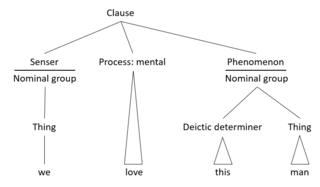Related Research Articles

Functional linguistics is an approach to the study of language characterized by taking systematically into account the speaker's and the hearer's side, and the communicative needs of the speaker and of the given language community. Linguistic functionalism spawned in the 1920s to 1930s from Ferdinand de Saussure's systematic structuralist approach to language (1916).
The following outline is provided as an overview and topical guide to linguistics:

Michael Alexander Kirkwood Halliday was a British linguist who developed the internationally influential systemic functional linguistics (SFL) model of language. His grammatical descriptions go by the name of systemic functional grammar. Halliday described language as a semiotic system, "not in the sense of a system of signs, but a systemic resource for meaning". For Halliday, language was a "meaning potential"; by extension, he defined linguistics as the study of "how people exchange meanings by 'languaging'". Halliday described himself as a generalist, meaning that he tried "to look at language from every possible vantage point", and has described his work as "wander[ing] the highways and byways of language". But he said that "to the extent that I favoured any one angle, it was the social: language as the creature and creator of human society".

Systemic functional grammar (SFG) is a form of grammatical description originated by Michael Halliday. It is part of a social semiotic approach to language called systemic functional linguistics. In these two terms, systemic refers to the view of language as "a network of systems, or interrelated sets of options for making meaning"; functional refers to Halliday's view that language is as it is because of what it has evolved to do. Thus, what he refers to as the multidimensional architecture of language "reflects the multidimensional nature of human experience and interpersonal relations."

In linguistics and related fields, pragmatics is the study of how context contributes to meaning. The field of study evaluates how human language is utilized in social interactions, as well as the relationship between the interpreter and the interpreted. Linguists who specialize in pragmatics are called pragmaticians. The field has been represented since 1986 by the International Pragmatics Association (IPrA).
Universal pragmatics (UP), more recently placed under the heading of formal pragmatics, is the philosophical study of the necessary conditions for reaching an understanding through communication. The philosopher Jürgen Habermas coined the term in his essay "What is Universal Pragmatics?" where he suggests that human competition, conflict, and strategic action are attempts to achieve understanding that have failed because of modal confusions. The implication is that coming to terms with how people understand or misunderstand one another could lead to a reduction of social conflict.

Discourse analysis (DA), or discourse studies, is an approach to the analysis of written, vocal, or sign language use, or any significant semiotic event.
Communicative language teaching (CLT), or the communicative approach (CA), is an approach to language teaching that emphasizes interaction as both the means and the ultimate goal of study.

Genre studies is an academic subject which studies genre theory as a branch of general critical theory in several different fields, including art, literature, linguistics, rhetoric and composition studies.
In sociolinguistics, a register is a variety of language used for a particular purpose or particular communicative situation. For example, when speaking officially or in a public setting, an English speaker may be more likely to follow prescriptive norms for formal usage than in a casual setting, for example, by pronouncing words ending in -ing with a velar nasal instead of an alveolar nasal, choosing words that are considered more "formal", and refraining from using words considered nonstandard, such as ain't and y'all.
In linguistics, linguistic competence is the system of unconscious knowledge that one knows when they know a language. It is distinguished from linguistic performance, which includes all other factors that allow one to use one's language in practice.
Coherence in linguistics is what makes a text semantically meaningful. It is especially dealt with in text linguistics. Coherence is achieved through syntactical features such as the use of deictic, anaphoric and cataphoric elements or a logical tense structure, as well as presuppositions and implications connected to general world knowledge. The purely linguistic elements that make a text coherent are subsumed under the term cohesion.
The sequence between semantic related ordered words is classified as a lexical chain. A lexical chain is a sequence of related words in writing, spanning narrow or wide context window. A lexical chain is independent of the grammatical structure of the text and in effect it is a list of words that captures a portion of the cohesive structure of the text. A lexical chain can provide a context for the resolution of an ambiguous term and enable disambiguation of concepts that the term represents.
Cohesion is the grammatical and lexical linking within a text or sentence that holds a text together and gives it meaning. It is related to the broader concept of coherence.
In semiotics, linguistics, sociology and anthropology, context refers to those objects or entities which surround a focal event, in these disciplines typically a communicative event, of some kind. Context is "a frame that surrounds the event and provides resources for its appropriate interpretation". It is thus a relative concept, only definable with respect to some focal event within a frame, not independently of that frame.
Social semiotics is a branch of the field of semiotics which investigates human signifying practices in specific social and cultural circumstances, and which tries to explain meaning-making as a social practice. Semiotics, as originally defined by Ferdinand de Saussure, is "the science of the life of signs in society". Social semiotics expands on Saussure's founding insights by exploring the implications of the fact that the "codes" of language and communication are formed by social processes. The crucial implication here is that meanings and semiotic systems are shaped by relations of power, and that as power shifts in society, our languages and other systems of socially accepted meanings can and do change.
Linguistics is the scientific study of language. Linguistics is based on a theoretical as well as a descriptive study of language and is also interlinked with the applied fields of language studies and language learning, which entails the study of specific languages. Before the 20th century, linguistics evolved in conjunction with literary study and did not exclusively employ scientific methods.
Skopos theory, a theory in the field of translation studies, employs the prime principle of a purposeful action that determines a translation strategy. The intentionality of a translational action stated in a translation brief, the directives, and the rules guide a translator to attain the expected target text translatum.

Ruqaiya Hasan was a professor of linguistics who held visiting positions and taught at various universities in England. Her last appointment was at Macquarie University in Sydney, from which she retired as emeritus professor in 1994. Throughout her career she researched and published widely in the areas of verbal art, culture, context and text, text and texture, lexicogrammar and semantic variation. The latter involved the devising of extensive semantic system networks for the analysis of meaning in naturally occurring dialogues.
The term metafunction originates in systemic functional linguistics and is considered to be a property of all languages. Systemic functional linguistics is functional and semantic rather than formal and syntactic in its orientation. As a functional linguistic theory, it claims that both the emergence of grammar and the particular forms that grammars take should be explained "in terms of the functions that language evolved to serve". While languages vary in how and what they do, and what humans do with them in the contexts of human cultural practice, all languages are considered to be shaped and organised in relation to three functions, or metafunctions. Michael Halliday, the founder of systemic functional linguistics, calls these three functions the ideational, interpersonal, and textual. The ideational function is further divided into the experiential and logical.
References
- ↑ Trappes-Lomax, Hugh (2004) "Discourse analysis", in The Handbook of Applied Linguistics ed. by A. Davies & C. Elder. Oxford: Blackwell, pp. 133–64.
- 1 2 Al-Amri, K. H. (2007). "Text-linguistics for students of translation". King Saud University. Retrieved 10 August 2012.
- ↑ Werlich, E. (1976), A text grammar of English. Heidelberg: Quelle & Meyer.
- 1 2 De Beaugrande, R., & Dressler, W. U. (1981) Introduction to text linguistics / Robert-Alain De Beaugrande, Wolfgang Ulrich Dressler. London; New York : Longman, 1981.
- ↑ Halliday, M.A.K. and Hasan, R. (1976) "'Cohesion in English London: Longman, pp. 1–2
- ↑ Roger Fowler. (1991) Language in the News: Discourse and Ideology in the Press. London/ New York: Routledge.
- ↑ Hatim, Basil & Ian Mason. (1990) Discourse and the Translator. London: Longman.
- ↑ Halliday MAK and R Hasan. (1985) Language, Context, and Text: Aspects of Language in a Social-Semiotic Perspective. Geelong: Deakin University.
- 1 2 3 Kavcic, A. (2008) Text linguistics. Informally published manuscript, English and German Studies, Retrieved from www.englistika.info/podatki/3_letnik/besediloslovje-I-izpiski.doc
- ↑ A. Crane, Paul. "Texture in Text: A Discourse Analysis of a News Article Using Halliday and Hasan's Model of Cohesion" (PDF). Retrieved 10 August 2012.
- ↑ Schegloff, E.A. and Sacks, H. (1974) "Opening up Closings", Semiotica 7(4): 289–327 (reprinted in Turner, R 1974 "'Ethnomethodology: selected readings,'" Harmondsworth: Penguin)
- ↑ Eggins, S. (1994) An Introduction to Systemic Functional Linguistics London: Pinter
- 1 2 Medina, Beatriz López (2002–2003). "The role of text linguistics in the foreign language class" (PDF). Encuentro Revista de investigación e innovación en la clase de idiomas: 148–156. Retrieved 10 August 2012.
- ↑ Beaugrande, Robert de. "Robert de Beaugrande Homepage". Archived from the original on 7 September 2013. Retrieved 10 August 2012.